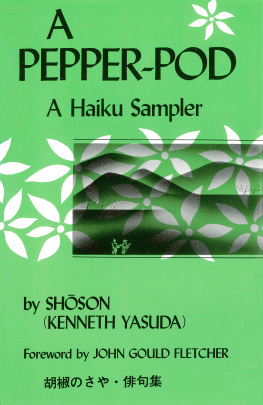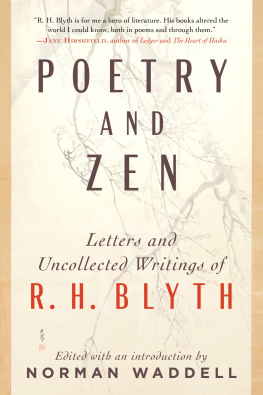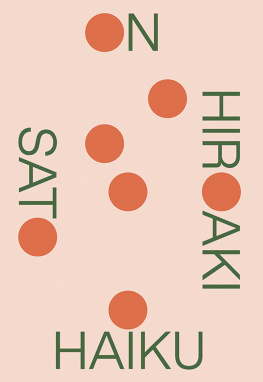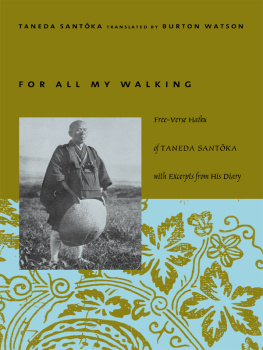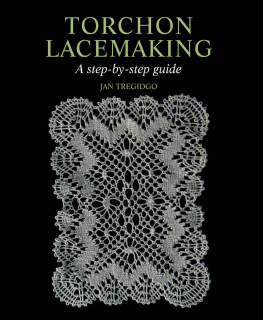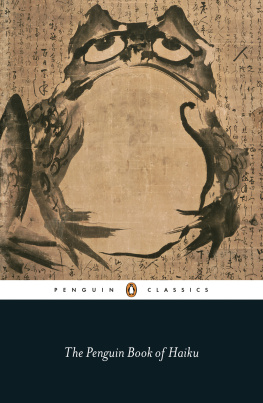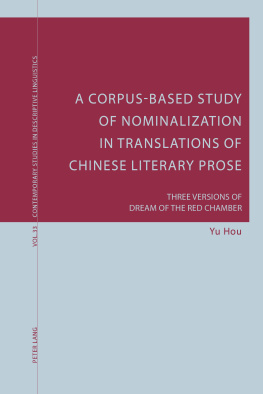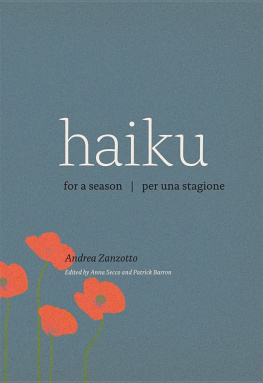Yasuda - A pepper-pod: a haiku sampler
Here you can read online Yasuda - A pepper-pod: a haiku sampler full text of the book (entire story) in english for free. Download pdf and epub, get meaning, cover and reviews about this ebook. City: Rutland;Vt, year: 1976, publisher: Tuttle Publishing;C.E. Tuttle Co, genre: Children. Description of the work, (preface) as well as reviews are available. Best literature library LitArk.com created for fans of good reading and offers a wide selection of genres:
Romance novel
Science fiction
Adventure
Detective
Science
History
Home and family
Prose
Art
Politics
Computer
Non-fiction
Religion
Business
Children
Humor
Choose a favorite category and find really read worthwhile books. Enjoy immersion in the world of imagination, feel the emotions of the characters or learn something new for yourself, make an fascinating discovery.
A pepper-pod: a haiku sampler: summary, description and annotation
We offer to read an annotation, description, summary or preface (depends on what the author of the book "A pepper-pod: a haiku sampler" wrote himself). If you haven't found the necessary information about the book — write in the comments, we will try to find it.
Yasuda: author's other books
Who wrote A pepper-pod: a haiku sampler? Find out the surname, the name of the author of the book and a list of all author's works by series.
A pepper-pod: a haiku sampler — read online for free the complete book (whole text) full work
Below is the text of the book, divided by pages. System saving the place of the last page read, allows you to conveniently read the book "A pepper-pod: a haiku sampler" online for free, without having to search again every time where you left off. Put a bookmark, and you can go to the page where you finished reading at any time.
Font size:
Interval:
Bookmark:
Griffith, Dr. L. Zilman, and Professor George Savage of the University of Washington for their useful and frank criticism. Also my heartfelt thanks are due to John Gould Fletcher, who read the entire manuscript and kindly wrote a foreword to this volume. Finally, I wish to express my appreciation for the sustained interest and encouragement shown by Sada Murayama, without whose inspiration this book could not have seen the light. K. Y.

Continental Europe: BOXERBOOKS, INC., Zurich
British Isles: PRENTICE-HALL INTERNATIONAL, INC., London
Australasia: PAUL FLESCH & CO., PTY.

Continental Europe: BOXERBOOKS, INC., Zurich
British Isles: PRENTICE-HALL INTERNATIONAL, INC., London
Australasia: PAUL FLESCH & CO., PTY.
LTD.
c/o Bookwise Australia
104 Sussex Street, Sydney
Canada: HURTIG PUBLISHERS, Edmonton
Published by the Charles E. Tuttle Company, Inc.
of Rutland, Vermont & Tokyo, Japan
with editorial offices at
Osaki Shinagawa-ku, Tokyo 141-0032 Copyright in Japan, 1976, by Charles E. Tuttle Co., Inc. All rights reserved ISBN: 978-1-4629-1156-1 (ebook) First edition, 1947 by Alfred A. Knopf, Inc., New York
First Tuttle edition, 1976
0292-000369-4615
PRINTED IN JAPAN

a bridge may be built between East and West
 FOREWORD A POEM is always, in whatever language it is written, a pattern of words designed to suggest something to the mind of a reader; and what a poem does suggest unless it happens to be pure nonsense is an object existing in time and space. This object may be taken from something existing inside the poet, of which only the poet is fully aware; or it may be taken from something outside, which has appeared to the poet as being an objective parallel to his own inner feelings.
FOREWORD A POEM is always, in whatever language it is written, a pattern of words designed to suggest something to the mind of a reader; and what a poem does suggest unless it happens to be pure nonsense is an object existing in time and space. This object may be taken from something existing inside the poet, of which only the poet is fully aware; or it may be taken from something outside, which has appeared to the poet as being an objective parallel to his own inner feelings. Most poems if not all poems have in them both kinds of experience: they largely represent, if lyrical in intention, the inner experience of the poet himself, which through a power of magic imagination, amounting to identification, is linked to some external object or occasion, and which acts as a key to unlock that inner experience and to create the pleasures of which the poem is made. This is as true of the form of poetry that the Japanese poets call haiku as it is of any other. The only difference between the Japanese haiku poet, and the Western English or American poets is this: the Japanese is content to suggest an object, and leaves the resulting emotion for the reader to complete in his own mind. The Western poet states the emotion, along with the object or objects that provoked it; and frequently in stating his emotion, he overdoes it. This may be the reason why poetry is unpopular among the English or the Americans; and why haiku -making is still popular among the Japanese. Reading through Mr.
Yasuda's skillful translations and I have never seen any translations of haiku poems which seemed to me to contain so much of the tonal quality of the Japanese I am again struck, as I was years ago, with the extraordinary power these poems have to set up echoes in the reader's mind, by the use of what Mr, Yasuda wittily calls "versegrams." Only the barest indication, in seventeen syllables, is allowed in the haiku; as for the reason, I must leave the reader to Mr, Yasuda's "Introduction," a magnificent and completely convincing explanation of the subject. These brief "versegrams" made up of detail which sometimes appears trivial have a terrific psychological impact, as Mr. Yasuda points out. One is reminded by them of the fact, that had Keats been a Japanese poet, instead of writing an "Ode to a Nightingale" in eight long stanzas, all he need have written were the two best lines: Charmed magic casements, opening on the foam Of perilous seas, in faery lands forlorn. I have already referred to the seeming triviality of the detail in many of these haiku poems. Mr. Mr.
Yasuda, who writes under the pen-name of Shoson, a name made up from the last syllables of the names of Basho and Buson, the two most celebrated haiku poets, seems to me the only translator of the many whom I have read in German, French, or English, who understands fully the spirit as well as the letter of the haiku form. Mr. Yasuda is an educated and cultivated Japanese-American, which is bis advantage over the others who have previously attempted to translate haiku poems into English; just as it is his personal misfortune, at the present moment, to be a Japanese-American, since we have been, so recently, at war with Japan. However, J happen to think that this misfortune which Mr. Yasuda shares with thousands of others will, in the long run, be overweighed by the advantages. We, though we have succeeded in conquering the Japanese people, can never destroy them completely, and will in fact have to learn from them, as they can learn from us, now that this war is finished.
What we can learn since we are far from perfect is important; and a great deal of it is stated and suggested in Mr. Yasuda's translations and experimental adaptations, as well as in his introductory essay. It is something that may help to lead poetry back to first principles, which surely should come first; and should lead some of the more intelligent moderns to cast off the burden of too-conscious intellectualism that they carry. For the merit of these haiku poems is not only that they suggest much by saying little; they also, if understood in connection with the Zen doctrine they illuminate, make of poetry an act of life. JOHN GOULD FLETCHER Little Rock
January 18, 1946 A PEPPER-POD 
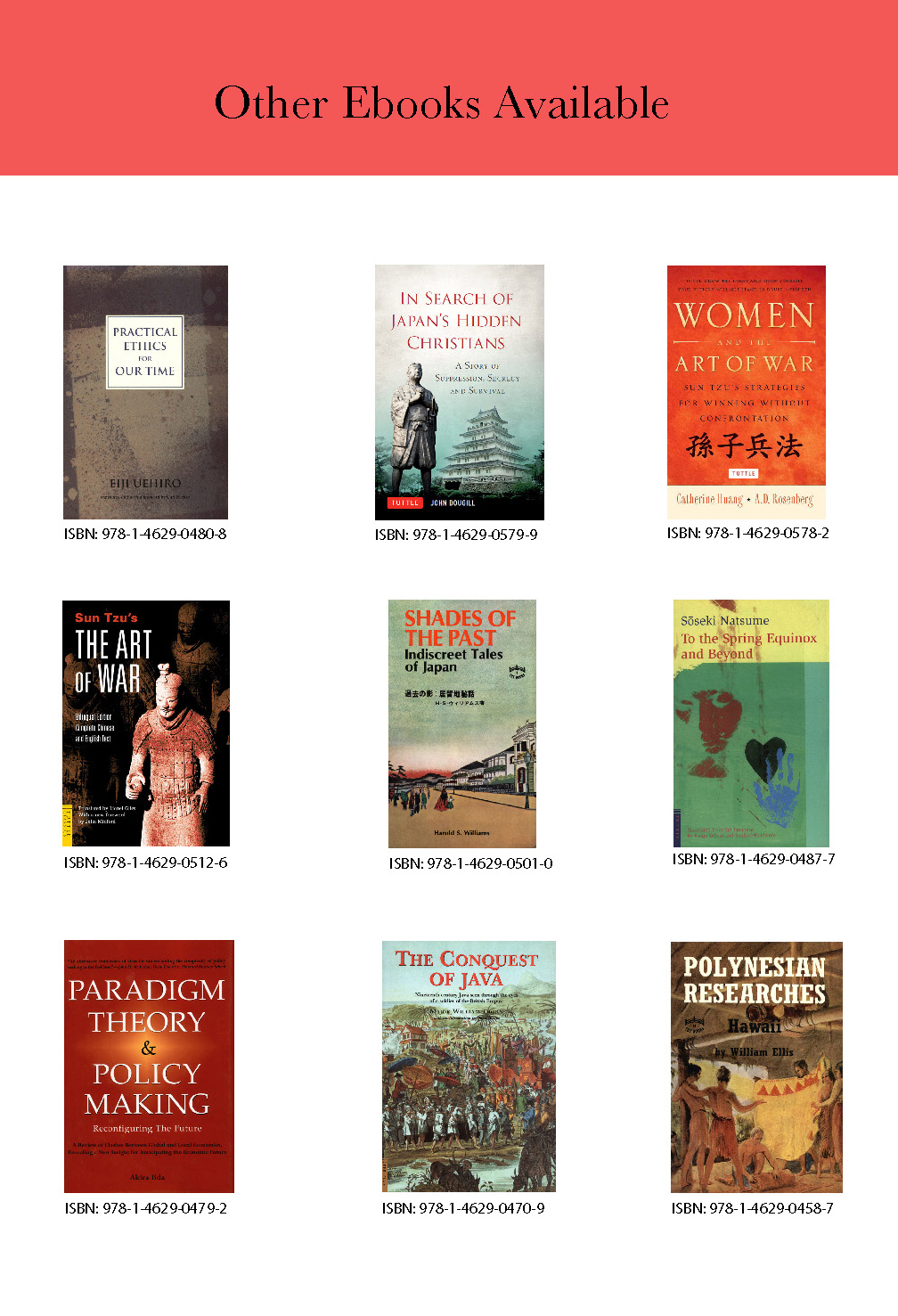
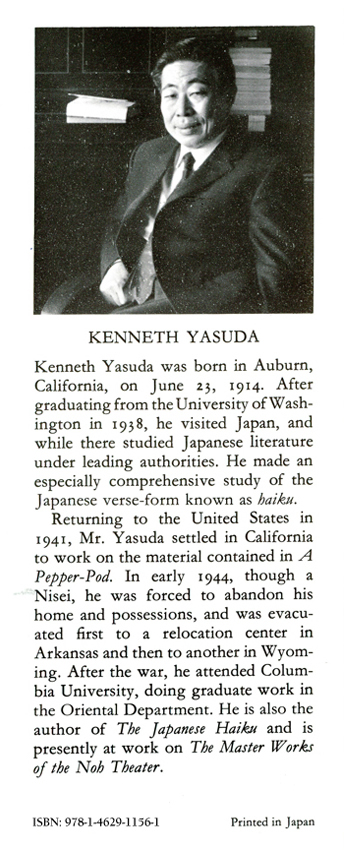
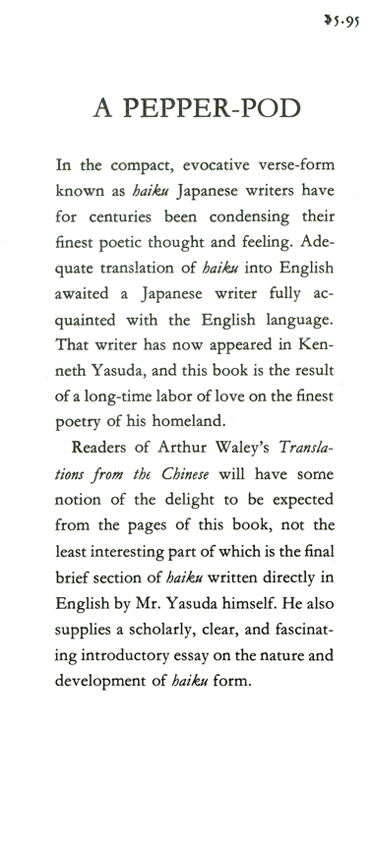
Unlike an oil painting, it fills the space without filling it, as when a sampan rises out of a silver mist of the Yangtse river, the faint outlines of distant mountains appear far beyond, and a pagoda's darker lines float between and above the misty veil over the rich valley. A picture, whether a portrait or a scene as described above, can be enjoyed just by looking at it. Painting is easy to appreciate, even for those who are illiterate. No special knowledge is required: at a glance one can feel all that is there. This is called "intuition." Thus any work of colors is to be esteemed, praised, valued through this act of immediate perception of beauty without conscious effort or reasoning. The same holds true of poetry and especially of haiku, a one-breath poem in three lines, a single flower of beauty whose petals are seventeen syllables, all told.
Font size:
Interval:
Bookmark:
Similar books «A pepper-pod: a haiku sampler»
Look at similar books to A pepper-pod: a haiku sampler. We have selected literature similar in name and meaning in the hope of providing readers with more options to find new, interesting, not yet read works.
Discussion, reviews of the book A pepper-pod: a haiku sampler and just readers' own opinions. Leave your comments, write what you think about the work, its meaning or the main characters. Specify what exactly you liked and what you didn't like, and why you think so.

